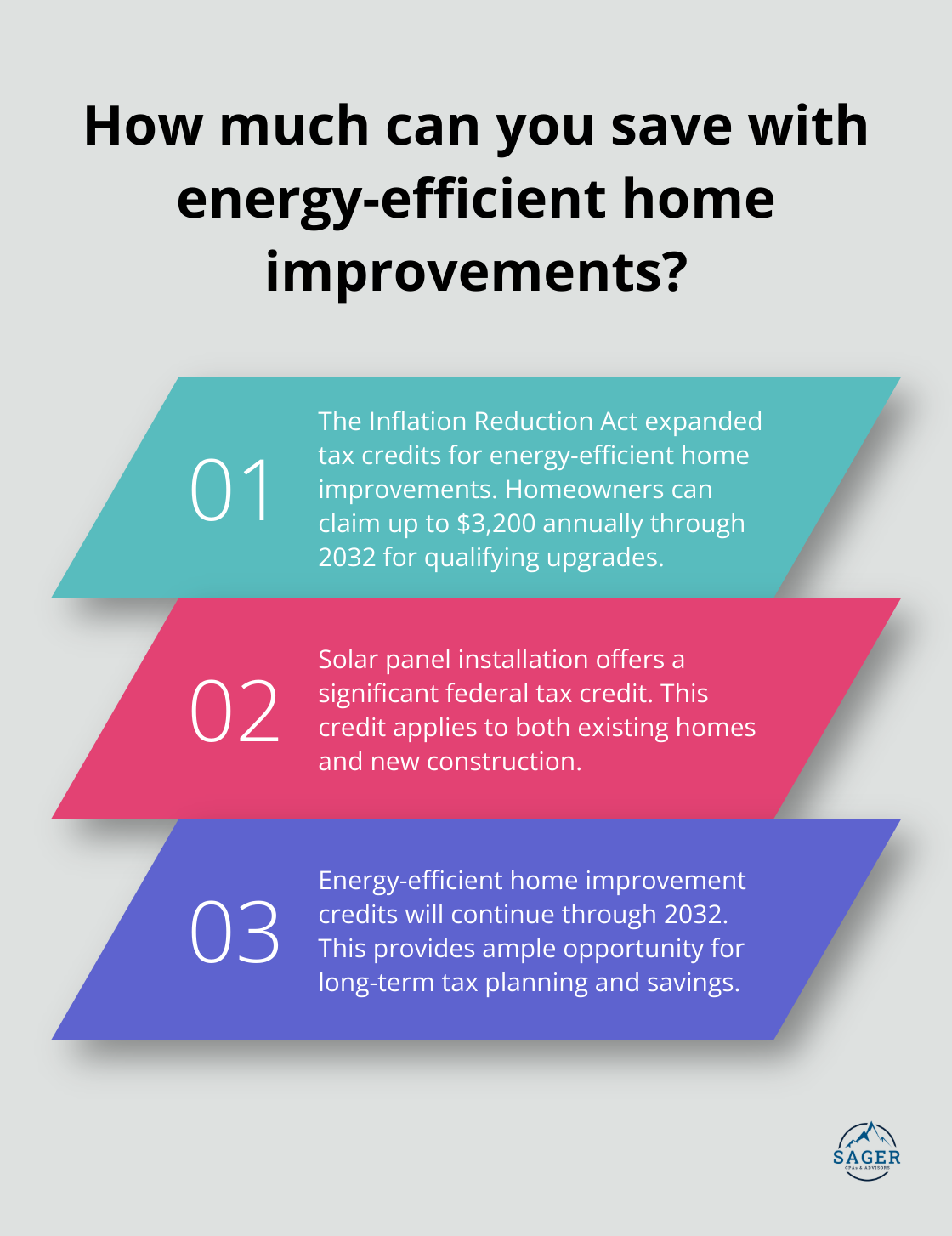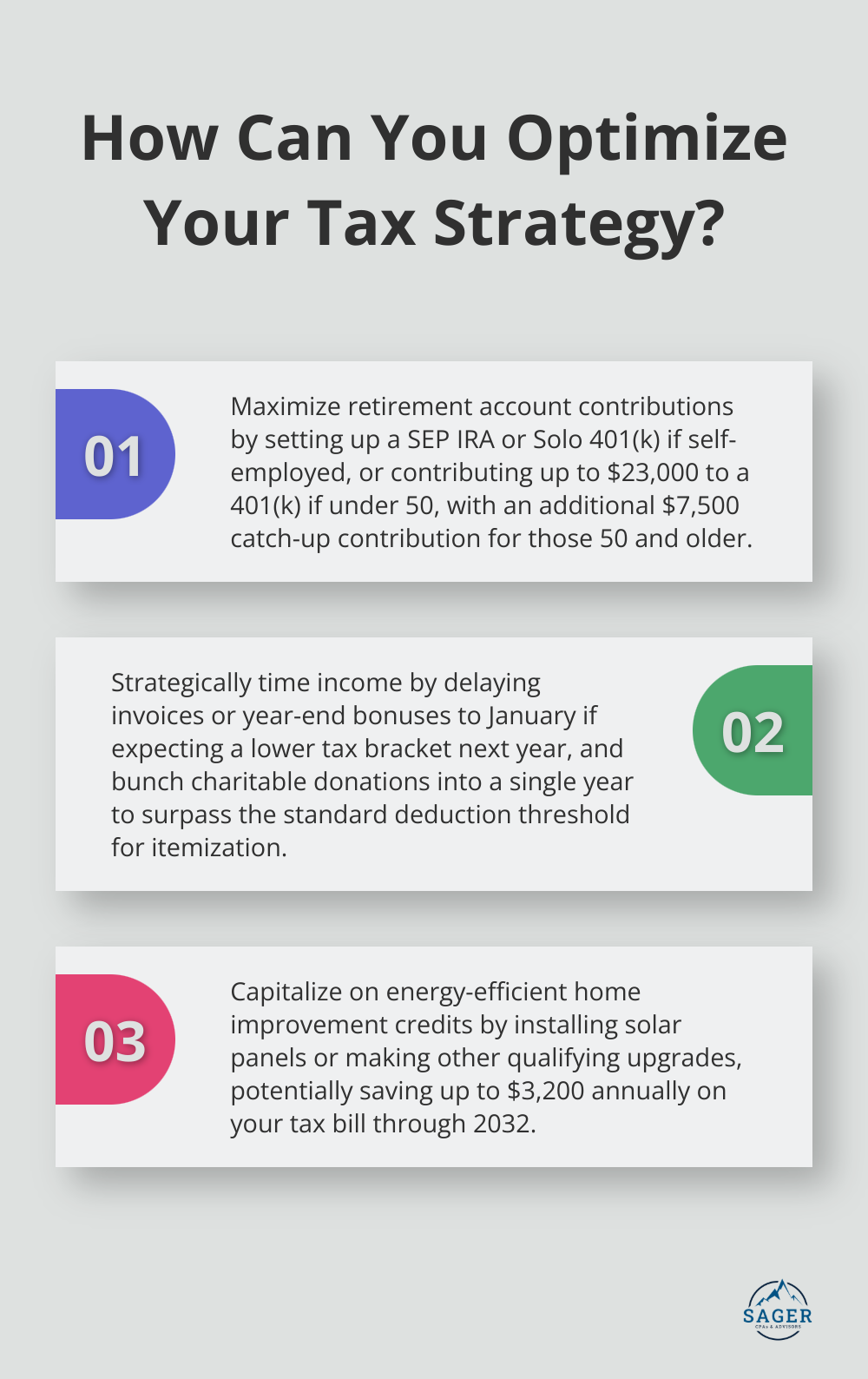
As we approach 2024, it’s time to get ahead of the game with smart tax planning strategies. The tax landscape is constantly evolving, and staying informed is key to optimizing your financial situation.
At Sager CPA, we’ve compiled the top tax planning strategies for 2024 to help you navigate these changes effectively. This guide will walk you through the latest updates, maximizing deductions, and making savvy retirement decisions to minimize your tax burden.
The tax landscape for 2024 introduces several important changes that will impact your financial planning. These updates require careful consideration to optimize your tax situation.
For the 2024 tax year, the IRS has adjusted tax brackets for inflation. The standard deduction rises to $14,600 for single taxpayers and married individuals filing separately, an increase of $750 from 2023. This adjustment necessitates a review of your withholding and estimated tax payments to avoid underpayment penalties.
Retirement savers will benefit from increased contribution limits in 2024. The limits for 401(k), 403(b), and most 457 plans have risen to $23,000. If you’re 50 or older, you can make an additional catch-up contribution of $7,500. IRA contribution limits have also increased to $7,000, with an extra $1,000 catch-up contribution for those 50 and above. These increases offer an excellent opportunity to boost your retirement savings while potentially lowering your taxable income.
The Inflation Reduction Act has introduced several new tax credits aimed at promoting clean energy. Qualifying energy projects may be eligible for additional tax credit amounts, also known as bonuses. These credits not only reduce your tax bill but also encourage environmentally friendly choices.
Business owners should note changes in depreciation rules and research and development (R&D) expense treatment. The bonus depreciation percentage has decreased to 80% for qualified property acquired and placed in service in 2024. R&D expenses now require amortization over five years for domestic research (15 years for foreign research), impacting cash flow for many businesses.
The $10,000 cap on state and local tax deductions remains in effect for 2024. This limitation continues to affect taxpayers in high-tax states, making it essential to explore alternative strategies to maximize deductions.

Tax laws are complex and subject to change. While we’ve highlighted key updates, this list isn’t exhaustive. To fully leverage these changes and create an optimal tax strategy for 2024, consider consulting with a tax professional. A personalized approach will help align your financial goals with the latest tax regulations, setting the stage for effective deduction and credit maximization strategies.
In 2024, you can significantly reduce your tax liability and keep more money in your pocket by maximizing your tax deductions and credits. Let’s explore effective strategies to optimize your tax position.
The increased standard deduction has made itemizing less common, but it remains beneficial for many taxpayers. If your total itemized deductions exceed the standard deduction ($14,600 for single filers, $29,200 for married filing jointly in 2024), you should itemize.

Consider bunching your charitable donations into a single year to surpass the standard deduction threshold. For example, if you typically donate $5,000 annually, you could donate $10,000 every other year. This approach allows you to itemize in one year and take the standard deduction in the alternate year, potentially saving thousands in taxes over time.
Medical expenses offer another opportunity for strategic planning. Try to schedule significant medical costs in the same tax year. You can only deduct medical expenses that exceed 7.5% of your adjusted gross income (AGI).
Business owners and self-employed individuals must properly track and claim business expenses. The home office deduction remains valuable for those who use a portion of their home exclusively for business. In 2024, you can choose between the simplified method ($5 per square foot, up to 300 square feet) or the regular method, which allows you to deduct a percentage of your home expenses based on the area used for business.
Don’t overlook vehicle expenses if you use your car for business. You can either deduct actual expenses or use the standard mileage rate (adjusted annually by the IRS). Keep meticulous records of your business miles to maximize this deduction.
Professional development costs (courses, seminars, and certifications related to your business) are fully deductible. These expenses not only reduce your tax bill but also invest in your business’s future growth.
The Inflation Reduction Act has significantly expanded tax credits for energy-efficient home improvements. Through 2032, federal income tax credits are available to homeowners, allowing up to $3,200 annually to lower the cost of energy efficient home upgrades.
Installing solar panels remains one of the most lucrative energy-related tax credits. The federal government offers a tax credit for residential solar photovoltaic systems. This credit applies to both existing homes and new construction, making it an attractive option for homeowners looking to reduce both their energy bills and tax liability.
To ensure your upgrades qualify for the credits, work with certified contractors and obtain proper documentation. The energy-efficient home improvement credits will continue through 2032, providing ample opportunity for long-term tax planning.
These strategies can help you maximize your deductions and credits, potentially saving thousands on your 2024 tax bill. However, tax laws are complex and constantly evolving. For personalized advice tailored to your specific situation, consult with a tax professional. As we move forward, let’s explore smart income timing and retirement planning strategies to further optimize your tax position.
You can reduce your tax burden by timing your income strategically. If you’re self-employed or control your billing, consider delaying some invoices until January of the following year. This tactic proves especially beneficial if you expect to fall into a lower tax bracket in the upcoming year.

Employees might negotiate with their employers to postpone year-end bonuses until January. This action shifts the income into the next tax year, potentially lowering the current year’s tax bill. However, you must evaluate your overall financial situation to ensure this aligns with your long-term objectives.
Contributing to tax-advantaged retirement accounts effectively reduces your taxable income. In 2024, you can contribute up to $23,000 to a 401(k) if you’re under 50, and an additional $7,500 if you’re 50 or older. These contributions use pre-tax dollars, which lowers your taxable income for the year.
Self-employed individuals should consider setting up a SEP IRA or Solo 401(k). These accounts often have higher contribution limits than traditional IRAs, allowing you to save more for retirement while reducing your current tax liability.
For those with high-deductible health plans, Health Savings Accounts (HSAs) offer a triple tax advantage (tax-deductible contributions, tax-free growth, and tax-free withdrawals for qualified medical expenses). In 2024, individuals can contribute up to $4,150, and families can contribute up to $8,300.
Roth conversions serve as a powerful tool in your tax planning arsenal. Converting traditional IRA funds to a Roth IRA requires you to pay taxes on the converted amount now, but future withdrawals become tax-free. This strategy benefits those who expect to be in a higher tax bracket in retirement.
You should execute Roth conversions in years when your income is lower, or when market downturns have temporarily decreased the value of your IRA. This allows you to convert more shares at a lower tax cost, potentially leading to greater tax-free growth in the future.
Roth conversions require careful planning. The converted amount adds to your taxable income for the year, which could push you into a higher tax bracket. You should work with a tax professional to determine the optimal amount to convert each year based on your specific financial situation and long-term goals.
As you approach retirement, develop a tax-efficient withdrawal strategy. The order in which you withdraw from different accounts can significantly impact your tax liability. Generally, you should start with taxable accounts, then tax-deferred accounts (like traditional IRAs and 401(k)s), and finally tax-free accounts (like Roth IRAs).
This approach allows your tax-advantaged accounts to continue growing tax-free for as long as possible. However, you must also consider Required Minimum Distributions (RMDs) from traditional retirement accounts, which begin at age 73 (as of 2024).
Tax planning strategies for 2024 require a proactive and informed approach. Your unique financial circumstances, goals, and risk tolerance all influence the most suitable strategies for you. What benefits one taxpayer might not suit another, highlighting the importance of personalized tax planning.

Sager CPA specializes in tailored financial management and tax planning services for individuals and businesses. Our team of experts can help you navigate tax code complexities, identify savings opportunities, and develop a comprehensive strategy aligned with your financial objectives. We offer precise accounting, strategic advisory services, and comprehensive tax planning to reduce liabilities and enhance your financial clarity.
Professional guidance can significantly optimize your tax situation and help you achieve your financial goals. Don’t leave your financial future to chance. Take the first step towards a more secure financial future by scheduling a consultation with Sager CPA today.




Privacy Policy | Terms and Conditions | Powered by Cajabra
At Sager CPAs & Advisors, we understand that you want a partner and an advocate who will provide you with proactive solutions and ideas.
The problem is you may feel uncertain, overwhelmed, or disorganized about the future of your business or wealth accumulation.
We believe that even the most successful business owners can benefit from professional financial advice and guidance, and everyone deserves to understand their financial situation.
Understanding finances and running a successful business takes time, education, and sometimes the help of professionals. It’s okay not to know everything from the start.
This is why we are passionate about taking time with our clients year round to listen, work through solutions, and provide proactive guidance so that you feel heard, valued, and understood by a team of experts who are invested in your success.
Here’s how we do it:
Schedule a consultation today. And, in the meantime, download our free guide, “5 Conversations You Should Be Having With Your CPA” to understand how tax planning and business strategy both save and make you money.